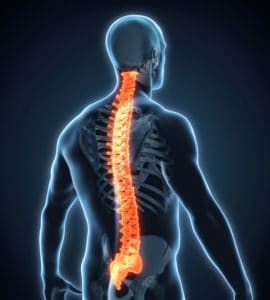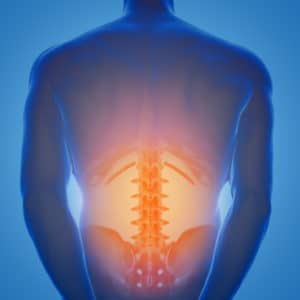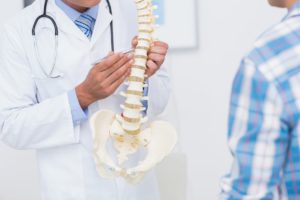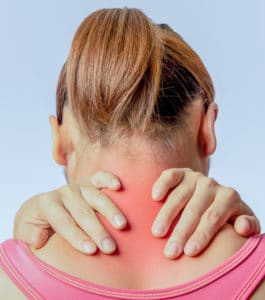Your spine is made up of a series of vertebrae with shock-absorbing discs between them. As a person ages, the spine can eventually develop degenerative changes in the intervertebral discs and the joints. If this degeneration is allowed to continue without proper medical intervention, it can lead to a debilitating and painful condition called spinal stenosis. Luckily, Todd J. Albert, MD offers spinal stenosis treatment in NYC.
Dial 212-606-1004 today to learn more about the spinal stenosis procedure or to determine whether you are a candidate for treatment!

What Is Spinal Stenosis?
Spinal stenosis refers to the gradual narrowing of the spinal canal. As the canal tightens, it can create pressure on the spinal cord, which may then lead to issues with movement and coordination in the arms and legs.
What Are The Causes Of Lumbar Spinal Stenosis?
There are numerous reasons that one may develop spinal stenosis. Bone spurs may develop around the vertebrae and facet joints. Degenerative changes in the supporting spinal ligaments may cause them to thicken, shrinking the space in the spinal canal. Arthritis can enlarge the joints. Disc protrusions and bulging or herniated discs can also narrow the spinal canal. Spinal stenosis usually continues to progress as the effects of any or all of these conditions keep narrowing the spinal canal putting more pressure on the spinal cord.
Stenosis is more common in the lower back, known as lumbar spinal stenosis. Cervical spinal stenosis, narrowing of the spinal canal in the neck, is considered a more serious condition and should be treated first.
Am I A Candidate For Spinal Stenosis Treatment?
Spinal stenosis usually occurs with increasing frequency as people age. Stenosis occurs over time often due to the effects of osteoarthritis, otherwise known as wear and tear arthritis. Over the years, this form of arthritis causes the breakdown of cartilage and the growth of bone. In the spine, this causes the spinal canal to narrow. The open spaces between the vertebrae get smaller, and bone spurs can develop. These changes lead to compression of the nerves in the area causing:
- Pain
- Tingling
- Numbness in the legs, arms, or torso, depending on where the stenosis is occurring.
Call 212-606-1004 to schedule a consultation for spinal stenosis and find out what treatment option you may be a candidate for.
What Are The Symptoms Of Spinal Stenosis?
Because the spinal cord is being impinged, the symptoms of stenosis are often nerve related. These are some of the typical symptoms:
- Arm pain
- Intermittent shooting pains into the arms and legs, especially when bending forward
- Deterioration of fine motor skills such as those needed to button your shirt
- Inability to walk briskly
- Loss of grip strength
- Heavy feeling in the bags
- Changes in bowel or bladder function

back with pain zone
When Should I Get Lumbar Spinal Stenosis Treatment?
The question of when to seek treatment is a personal one that is directly related to your functionality and ability to “live with the pain”. Other than pain, stenosis left unaddressed can lead to numbness and weakness in the hands and feet. This is because the nerve compression is beginning to cause damage to the nerves.
How Is Spinal Stenosis Treated?
There are a variety of treatment options that you can receive to treat spinal stenosis. Treatment includes non-surgical and surgical options, the goal is to avoid surgery if possible. The first step in discussing treatment is to schedule a consultation with Orthopedic Surgeon, Dr. Todd Albert. During the consultation, Dr. Albert will perform an examination and recommend a treatment plan.
Non-Surgical Treatments For Spinal Stenosis
If surgery is not needed, Dr. Albert provides non-surgical treatment options that may include the following:
- Medication — Anti-inflammatory medications and pain relievers may suffice for mild symptoms. Dr. Albert may also prescribe muscle relaxants if you’re having muscle spasms.
- Corticosteroid injections — If your nerve roots have become irritated and swollen in the areas of compression, Dr. Albert may recommend a steroid injection into the space around the nerve. While this does not correct the stenosis, it does reduce inflammation and may relieve the pain for a period of time. These injections, like most medical procedures, do have possible side effects and are only prescribed up to three times per year if indicated.
- Physical therapy — People with stenosis usually become less active due to the pain they are experiencing. The resulting muscle weakness further exacerbates the problem as the spine receives less support. Physical therapy can return strength, endurance, flexibility, and stability. It also can improve balance if the legs and feet have been affected.
Surgery For Spinal Stenosis
If non-surgical treatment does not alleviate the patient’s symptoms, Dr. Albert may recommend surgery as the next step. If surgery is needed, a decompression procedure such as a laminectomy may be recommended. Depending on the stability of your spine he may also recommend a cervical laminoplasty, or a cervical fusion for stenosis of the cervical spine. For lumbar stenosis the surgical options are typically a lumbar decompression surgery or a lumbar fusion.
Laminoplasty Surgery
Laminoplasty is performed only on the vertebrae in the cervical spine. The goal of this surgery is to open up space within the spinal canal.
During a laminoplasty, the lamina, which is a small section of bone that covers the back of the spinal cord, is cut through completely on one side and partially on the other side.

These cuts allow the bone to swing open like a door thereby creating more space in the spinal canal and relieving pressure from the spinal cord and nerve roots.
Once the lamina has been cut, Dr. Albert examines the spinal canal and removes any bone spurs and other sources of compression. To maintain the space, the lamina is held open with titanium spacers and plates.
Laminoplasty Recovery
After laminoplasty, particularly to treat spinal stenosis, patients will usually need to wear a soft collar for 2-3 weeks. Recovery times vary depending on the age and medical condition of the patient. For several weeks after surgery, you should avoid activities that require bending or lifting. Patients will then need to undergo rehabilitative therapy to build up strength, the range of motion and flexibility in the area. Patients will generally be out of work for 2-4 weeks after surgery and can resume most normal activities from 2-6 weeks after surgery.
Posterior Fusion Surgery
Posterior fusion surgery is performed through the back of the patient’s spine. This type of surgery is the most common type of fusion surgery for the lower back. The surgery fuses together two or more vertebrae into a single piece. This eliminates the instability that may have developed due to osteoarthritis, severe degenerative disc disease, or fractures in the lumbar spine. This fusion is most common in the lowest two vertebrae, L4 and L5, as they carry the most load and are the most prone to degradation and injury.
Spinal Stenosis Surgery Risks
Beyond the typical risks associated with major surgery, laminoplasty and posterior fusion surgeries have other risks. For example, a possible risk is nerve injury or the development of new numbness or tingling in the corresponding limbs, both of these are very rare. Fusion may also be complicated by the vertebrae not fusing solidly, which is called a pseudoarthrosis. While we do not see this very often in our practice it is a risk we associate with any fusion surgery.

Lumbar Spinal Stenosis Surgery Results
Posterior cervical laminoplasty surgery with Dr. Albert has a high success rate for alleviating pain and restoring function. Studies have shown that a majority of patients having this surgery report significant improvement in their function (the ability to perform normal daily activities) and a dramatic reduction in pain and discomfort.
Posterior fusion is also successful in over 80 percent of surgeries. The fusion prevents any movement between the two vertebrae, dramatically reducing and in many cases fully eliminating pain. The fused bones keep the patient from stretching nearby nerves, ligaments, and muscles that led to pain.
Todd J. Albert Patient Testimonial
"Great experience with Dr Albert. Able to quickly identify the issue, explain the options, and benefits & risks of surgery. Surgery was as expected. Great surgeon surrounded by an equally excellent supporting cast."
Click here to read more patient testimonials.
FAQs
Will Physical Therapy Help Spinal Stenosis?
In many cases, physical therapy can help alleviate the pain and neurological symptoms associated with spinal stenosis. In therapy, you will learn exercises that will improve your range of motion, flexibility, and improve spinal health and stability.
Is Surgery Always Necessary?
No, surgery is not always indicated for spinal stenosis. In some cases, patients are able to manage and even improve their symptoms with physical therapy and other conservative modalities. However, if spinal compression increases or you have increased loss of function, surgery may be considered.
How Can Treat Spinal Stenosis At Home?
Pain management and maintaining range of motion is important, so over-the-counter pain medication may be helpful. In addition, core-strengthening exercises can help to stabilize your lumbar spine, making it easier to walk and perform activities of daily living.
Schedule A Consultation For Spinal Stenosis Treatment In NYC
If you have been experiencing any of the symptoms mentioned above, call 212-606-1004 or fill out our online form to schedule a consultation with Dr. Todd J. Albert. During your consultation, he can perform a proper evaluation that will help determine whether or not you are eligible to receive spinal stenosis treatment in NYC. From there, the most appropriate treatment plan can be proscribed.


